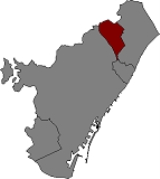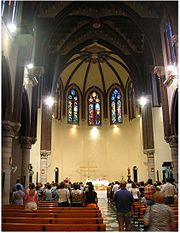
Santa Coloma de Gramenet
Encyclopedia
Santa Coloma de Gramenet (ˈsantə kuˈɫomə ðə ɣɾəməˈnɛt) (informally simply known as Santa Coloma; historically also known as Gramenet del Besòs) is a city in Catalonia
, Spain
. It is situated on the south-east side of the Litoral range, with the Puig Castellar (299 m)
as its highest point, on the left bank of the Besòs river: the municipalities of Sant Adrià de Besòs
and Badalona
separate it from the coast. It is essentially a banlieue
(or suburb) of Barcelona
.
The area has been inhabited since at least the Iberic period, and the remains of an Iberic village have been found on
Puig Castellar. The artefacts are housed in a museum in La Torre Balldovina, a building dating from the 18th century.
Other notable buildings include the renaissance
palace of La Torre Pallaresa and the noucentista
Clínica Mental.
In November 2008, the city made worldwide news by installing solar panels on top of crypts in the local cemetery, in an effort to help fight climate change.


Catalonia
Catalonia is an autonomous community in northeastern Spain, with the official status of a "nationality" of Spain. Catalonia comprises four provinces: Barcelona, Girona, Lleida, and Tarragona. Its capital and largest city is Barcelona. Catalonia covers an area of 32,114 km² and has an...
, Spain
Spain
Spain , officially the Kingdom of Spain languages]] under the European Charter for Regional or Minority Languages. In each of these, Spain's official name is as follows:;;;;;;), is a country and member state of the European Union located in southwestern Europe on the Iberian Peninsula...
. It is situated on the south-east side of the Litoral range, with the Puig Castellar (299 m)
as its highest point, on the left bank of the Besòs river: the municipalities of Sant Adrià de Besòs
Sant Adrià de Besòs
Sant Adrià de Besòs is a city in the comarca of the Barcelonès in Catalonia, northern Spain. It is situated at the mouth of the river Besòs, extending to both sides of the estuary. The original settlement with the parish church is on the left bank of the river, in the north of the municipal...
and Badalona
Badalona
Badalona is a city in eastern Catalonia, Spain. It is located in the comarca of the Barcelonès, near the city of Barcelona and part of its metropolitan area. It is situated on the left bank of the small Besòs River and on the Mediterranean Sea, backed by the Serra de la Marina mountain range...
separate it from the coast. It is essentially a banlieue
Banlieue
In francophone areas, banlieues are the "outskirts" of a city: the zone around a city that is under the city's rule.Banlieues are translated as "suburbs", as these are also residential areas on the outer edge of a city, but the connotations of the term "banlieue" in France can be different from...
(or suburb) of Barcelona
Barcelona
Barcelona is the second largest city in Spain after Madrid, and the capital of Catalonia, with a population of 1,621,537 within its administrative limits on a land area of...
.
The area has been inhabited since at least the Iberic period, and the remains of an Iberic village have been found on
Puig Castellar. The artefacts are housed in a museum in La Torre Balldovina, a building dating from the 18th century.
Other notable buildings include the renaissance
Renaissance
The Renaissance was a cultural movement that spanned roughly the 14th to the 17th century, beginning in Italy in the Late Middle Ages and later spreading to the rest of Europe. The term is also used more loosely to refer to the historical era, but since the changes of the Renaissance were not...
palace of La Torre Pallaresa and the noucentista
Noucentisme
Noucentisme was a Catalan cultural movement of the early 20th century that originated largely as a reaction against Modernisme, both in art and ideology, and was, simultaneously, a perception of art almost opposite to that of avantgardists...
Clínica Mental.
In November 2008, the city made worldwide news by installing solar panels on top of crypts in the local cemetery, in an effort to help fight climate change.


External links
- Official web site of Santa Coloma de Gramenet
- santako.com - Web site for people living in Santa Coloma de Gramenet (News, Events, Forums...)

